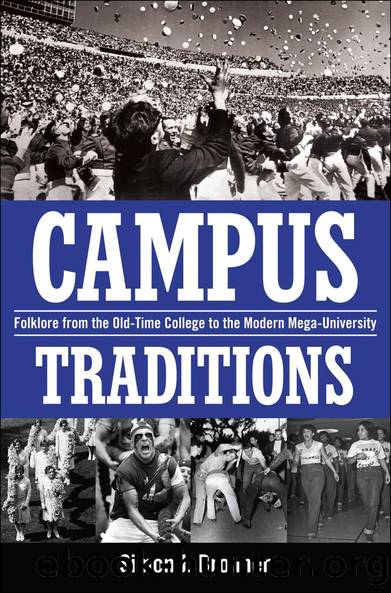Campus Traditions by Simon J. Bronner

Author:Simon J. Bronner [Bronner, Simon J.]
Language: eng
Format: epub
Tags: Education, Student Life & Student Affairs, Social Science, Folklore & Mythology, Popular Culture
ISBN: 9781617036163
Google: HJkkykeN-nkC
Barnesnoble:
Goodreads: 15897376
Publisher: Univ. Press of Mississippi
Published: 2012-09-10T00:00:00+00:00
7 CHAPTER
GREEK LIFE
FRATERNITIES AND SORORITIES OFTEN VIEW THEMSELVES AS UPHOLDers of tradition and collegiate spirit leaders. Many fraternity and sorority members declare Greek letter societies as a traditional place in the college where âmeâ becomes âus.â Fraternal organizations sing the praises of fellowship, ritually honor âbrothersâ and âsisters,â and parade the value of civic engagement, particularly in an individualistic, self-absorbed mass society. But as organizations that enclose themselves in separate houses and carry the stigma of secret societies, fraternities and sororities are subject to suspicion, restriction, reform, disparagement, suspension, and, at many campuses, banishment. Greeks recognize in a kind of double consciousness that many college characters see them as despoilers of campus integrity or social progress. The conflict of perceptions is especially acute in the public square because of the fear that the Greeks form an insidious cartel that, even if small, wields power over the collegiate superstructure. Questions naturally arise about the power and abuse the fraternities and sororities exert, what they are up to, who got in, and who did not.
The Greek system is intended to foster lifelong benevolent values of fellowship and service, its defenders declare. Yet there is a public, and often administrative, apprehension of the exclusivity of the fraternities and sororities. The organizations are often assumed to be elitist and therefore arrogant, if not troublesome, and even defiant subcultures at the same time that they carry a line-toeing establishment aura. Another paradoxical combination of images is evident in traditional practices associated with fraternities and sororities of crude hazing, rowdy singing and pranking, pledging, initiation, and partying set off against their publicized activities as big-hearted service organizations, campus boosters, and well-mannered socialites. The debate heightens as universities have grown and the purposes of fraternities and sororities as debauched private worlds in a mass democratic society become matters of national concern.
Greek-letter fraternities have come a long way from their eighteenth-century roots in the founding of Phi Beta Kappa at the College of William and Mary. Latin-letter fraternities had already existed, and John Heath (1758â1810, destined to become a U.S. congressman), after failing to get into two of the organizations, created a precedent with the use of Greek-letter initials for the creation of an honorary society. Membership in the organization was more about academic status than brotherhood, and members included faculty as well as upperclassmen. Kappa Alpha at Union College in Schenectady, New York, organized in 1825, is credited with establishing the model of a modern fraternity with an exclusively student organization and elaborate initiation. Sigma Phi, formed in 1827 also at Union, became the first national fraternity when it opened a second chapter at Hamilton College in 1831. That led to the creation of other fraternities on the same campus to form a Greek system: Alpha Delta Phi in 1832 and Psi Upsilon in 1833 at Hamilton, Beta Theta Pi at Miami of Ohio in 1839, and Alpha Sigma Phi at Yale in 1845. Evolving from literary and debating societies, the early fraternities provided fellowship outside the control of college faculty and administrators.
Download
This site does not store any files on its server. We only index and link to content provided by other sites. Please contact the content providers to delete copyright contents if any and email us, we'll remove relevant links or contents immediately.
Deep learning with TensorFlow and Keras by Derrick mwiti(865)
Understanding PDA Autism in Kids: A Guide for Parents and Teachers to Support Neurodiverse Learners by Jehu Len(715)
The Victorian Era: A Captivating Guide to the Life of Queen Victoria and an Era in the History of the United Kingdom Known for Its Hierarchy-Based Social Order by Captivating History(498)
100 Ideas for Secondary Teachers: Engaging Parents by Janet Goodall & Kathryn Weston(477)
Intersectionality in Educational Research by Dannielle Joy Davis; James L. Olive; Rachelle J. Brunn-Bevel; Susan R. Jones(477)
How to be assertive in any situation by Hadfield Sue & Hasson Gill(461)
Writing Solid Code: Development Philosophies for Writing Bug-Free Programs by Steve Maguire(457)
Brain Teasers to Build Critical Thinking Skills: Brain Exercises for Tech, Banking, Case Interview Prep, and to Keep Your Mind Sharp by Kris Safarova(452)
Brain Teasers to Build Critical Thinking Skills by Safarova Kris(449)
Python 101 - Fundamentals by Sam(411)
Critical Curriculum Leadership : A Framework for Progressive Education by Rose M. Ylimaki(408)
The Art of Emotional Validation: Improve Your Communication Skills and Transform Your Relationships by Validating Emotions and Feelings by Emily Wright(377)
The Knights Templar: An Enthralling History of the Rise and Fall of the Most Influential Catholic Military Order by Wellman Billy(368)
The Future Knowledge Compendium by Ellyard Peter;(364)
A Beginner's Guide to SSD Firmware by Unknown(364)
What Every Teacher Should Know about Learning, Memory, and the Brain by Tileston Donna E. Walker;(362)
NumPy : From Basic to Advance by bisht Karan Singh(349)
Making Connections in and Through Arts-Based Educational Research by Hala Mreiwed Mindy R. Carter Sara Hashem Candace H. Blake-Amarante(342)
Alma Maters (5th edition) by Unknown(336)
